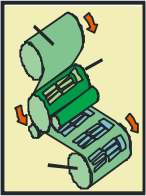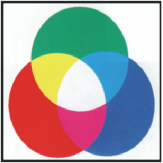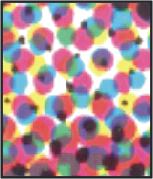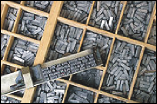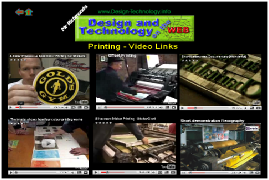























~ Design & Technology ~
Colour Theory and Printing
Colour Theory and Printing
Isaac Newton experimented with white light and discovered that it could be split into three primary light-colours of red, green and blue. The rainbow is an example of this when light from the sun is split into separate colours as it passes through millions of individual raindrops. Recombined, three discs of additive coloured light become white as shown here. So Red, Green and Blue are called Additive Primary colours. Two of these mixed together create a subtractive primary – These are called Yellow, Magenta and Cyan and are the basis of 4 colour printing – see below….
Colour printing can require the paper to pass through the printing process four times. (...or as many times as there are colours being printed....) The process shown here is the one most frequently used for full-colour work. It is called ‘Lithography’ and is based on the fact that oil and water do not mix. It uses a thin aluminium sheet on which the image has been etched photographically. This plate is then washed with an ink attracting chemical and the non-image area is lightly dampened. This repels the ink. When paper is pressed into contact with the roller the ink is transferred onto the paper from the areas it has been ‘sticking to’ - that is - the image areas.
Two main types of ‘litho’ are in common use. One is offset litho’ and transfers the ink to the
Printing is based on the ‘subtractive principle’ depending on several different colours being overlaid in a controlled manner. Each colour ‘mixes’ with the one printed before it - the end result finally being seen as a full colour picture.
So, Yellow (Y), Magenta (M) and Cyan(C) are the three main ‘printing colours’. These are the subtractive primary colours and along with Black (K - standing for Key-Line) are also known in printing as the four ‘process’ colours. When all four are mixed together they absorb almost all the colours contained in the white light that is falling onto them. Black (K) ink is added to strengthen the very dark brown that really occurs when the three are printed together. This close-up of a magazine image shows this very well. Notice that Magenta
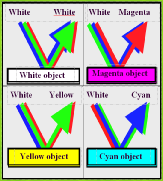
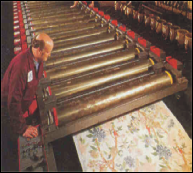
Coloured objects are only seen as a particular colour because other colours falling on them are absorbed. White card reflects all colours - Magenta ‘soaks-up’ the green - Yellow ‘soaks-up’ the blue and Cyan
‘soaks-up the red‘. What remains in each case is the observed colour. If you understand this
principle of how the colours mix together .
then the rest of colour printing is easy.
We are now only concerned with ‘how’ the
Ink is transferred onto the surface to be printed. In the picture to the right several rollers allow a different ink colour to pass through onto the paper or textiles and produce the desired pattern. As these
rollers contain different inks and as the printing pattern is on the surface of the
We are now only concerned with ‘how’ the
Ink is transferred onto the surface to be printed. In the picture to the right several rollers allow a different ink colour to pass through onto the paper or textiles and produce the desired pattern. As these
rollers contain different inks and as the printing pattern is on the surface of the
roller, the overall image will be made up of a repeated pattern that depend on the diameter of the roller for how frequently they repeat.
Subtractive Colour ~ 4-Colour Printing
And Yellow together make Red since both Yellow and Magenta include a Red component - Look at the arrows on the illustration in the section above to understand this and then check this out for yourself with a lens on a magazine
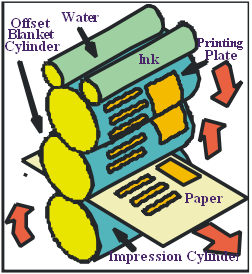
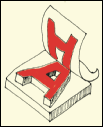
The simplest form of printing is ‘letterpress’. This is also the oldest and was used to print books from the early days of printing in the mid 15th C. The block-printing seen in the small image here is also using the same principle.
The illustration on the right shows a letter with paper being pressed into contact; resulting in a printed version of the shape that had been
inked. The left hand image with rollers is the
same process converted to the large scale production needed for newspapers.
inked. The left hand image with rollers is the
same process converted to the large scale production needed for newspapers.
Paper
Roll
Roll
Printing
Plate
Plate
Printed
Roll
Roll
Want to know more about colour ? >>

Why donate ?


